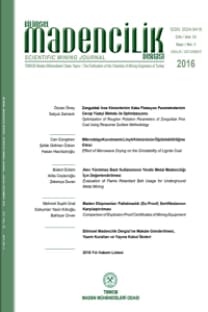BİR TÜNELDE PORTAL VE TÜNEL STABİLİTESİ İLİŞKİSİ (ANKARA-SİVAS YÜKSEK HIZLI DEMİRYOLU PROJESİ, T3 TÜNELİ)
Öz Son yıllarda hızlı bir gelişim gösteren ulaşım ağı projeleri kapsamında inşa edilen tünellerin en çok karşılaşılan sorunlarından biri portal şevlerinin duraylılığıdır. Portal şevlerinde meydana gelen yenilmeler zaman zaman tünelde de duraylılık problemlerine sebep olmakta ve sorunu büyütmektedir. Bu çalışma kapsamında, buna tipik bir örnek olan Ankara-Sivas Yüksek Hızlı Tren projesi kapsamında inşa edilen T3 Tünelinde meydana gelen yenilme incelenmektedir. Tünel kazısı devam ederken, çıkış portal kesimi şevlerinde çatlaklar meydana gelmiş ve aynı zaman da tünel gövdesinde de göçük meydana gelmiştir. Bu çalışma kapsamında hem göçen kesimin güvenle tekrar kazılması için sayısal analizler ile önerilen yeni destek sistemleri değerlendirilmekte, hem de portal kesiminde şev duraylılığının sağlanması için gerekli analizlerin yapılması ve sonuçların performansı tartışılmaktadır. Buna ek olarak, çalışmada genel olarak tünel portal kazısı ile tünel içi tahkimat sistemlerinin etkileşimi tanımlanarak, bu tür tünel çalışmaları için bir prosedür önerilmektedir.
Anahtar Kelimeler:
Tünel, Yenilme, Portal, Nümerik analiz
___
- Akgün, H., Muratlı, SW., Koçkar, M.K., 2014. Geotechnical Investigations and Preliminary Support Design for the Geçilmez Tunnel: A Case Study Along the Black Sea Coastal Highway, Giresun, Northern Turkey. Tunnelling and Underground Space Technology, 40, 277 – 299.
- Aygar, E.B and Gokceoglu, C., 2020. Problems Encountered During a Railway Tunnel Excavation in Squeezing and Swelling Materials and Possible Engineering Measures: A Case Study from Turkey. Sustainability, 12, 1166.
- Ayoublou, F., Taromi, M., Eftekhari, A., 2019. Tunnel Portal Instability in Landslide Area and Remedial Solution: A Case Study. Acta Polytechnica, 59(5), 435– 447.
- Fugro Sial Yerbilimleri, 2015. Ankara-Sivas Hızlı Tren Demiryolu Projesi Yerköy-Yozgat-Sivas Arası, T3 Tüneli (Km: 293+375 - 293+400) Arasında Meydana Gelen Göçük Değerlendirme Raporu.
- Geniş, M., 2010. Assessment of the Dynamic Stability of the Portals of the Dorukhan Tunnel Using Numerical Analysis. International Journal of Rock Mechanics & Mining Sciences, 47, 1231–1241.
- Kaya, A., Akgün, A., Karaman, K., Bulut, F., 2016. Understanding the Mechanism of Slope Failure on a Nearby Highway Tunnel Route by Different Slope Stability Analysis Methods: A Case From NE Turkey. Bull Eng Geol Environ, 75, 945–958.
- Kaya, A., Karaman, K., Bulut, F., 2017. Geotechnical Investigations and Remediation Design for Failure of Tunnel Portal Section: A Case Study in Northern Turkey. Journal of Mountain Sciences, 14 (6), 1140 – 1160.
- Khan, R.M.A., Mad, Z., Jo, B., 2019. Tunnel Portal Construction Using Sequential Excavation Method: A Case Study. Acta Polytechnica, 59(5), 435–447.
- Koçkar, M.K., Akgün, H., 2003. Methodology for Tunnel and Portal Support Design in Mixed Limestone, Schist and Phyllite Conditions: A Case Study in Turkey. International Journal of Rock Mechanics & Mining Sciences, 40, 173 – 196.
- Komu, M.P., Guney, U., Kilickaya, T.E., Gokceoglu, C., 2020. Using 3D Numerical Analysis for the Assessment of Tunnel–Landslide Relationship: Bahce–Nurdag Tunnel (South of Turkey). Geotech Geol Eng, 38, 1237–1254.
- Hammah, R.E., Yacoub, T.E., and Corkum, B.C., 2005. The Shear Strength Reduction Method for the Generalized Hoek-Brown Criterion. ARMA/USRMS, American Rock Mechanics Association, 05-810.
- Li, T., 2012. Damage to Mountain Tunnels Related to the Wenchuan Earthquake and Some Suggestions for Aseismic Tunnel Construction. Bull Eng Geol Environ, 71, 297–308.
- Moussaei, N., Sharifzadeh, M., Sahriar, K., Khosravi, M.H., 2019. A New Classification of Failure Mechanisms at Tunnels in Stratified Rock Masses Through Physical and Numerical Modelling. Tunnelling and Underground Space Technology, 91, 103017.
- Rabcewicz, L.v., 1964a. The New Austrian Tunnelling Method, Part One. Water Power, pp. 453–457.
- Rabcewicz, L.v.,1964b. The New Austrian Tunnelling Method, Part Two. Water Power, pp. 511–515.
- Rabcewicz, L.v., 1965. The New Austrian Tunnelling Method, Part Three. Water Power, pp. 19–24.
- Rao, K., Singh, T., 2017. Two-Dimensional Finite Element Based Parametric Analysis of South Portal Slope, Rohtang Tunnel, India. Procedia Engineering, 173, 1330 – 1333.
- RocScience, 2020. Phase2 8.0 Excavation & Support Design. https://rocscience.com/documents/pdfs/up loads/8706.pdf.
- Roy, N., Sarkar, R., 2017. A Review of Seismic Damage of Mountain Tunnels and Probable Failure Mechanisms. Geotech Geol Eng, 35, 1–28.
- Sönmez, H., Ulusay, R., Gokceoglu, C., 1998. A Practical Procedure for the Back Analysis of Slope Failures in Closely Jointed Rock Masses. International Journal of Rock Mechanics & Mining Sciences, 35 (2), 219 – 233.
- Taromi M., Eftekhari A., Hamidi J. K., Eghbali A., 2018. Tunnel Designing and Construction Process in Difficult Ground Conditions Using Controlled Deformations (ADECO) Approach: A Case Study. International Journal of Mining and Geo-Engineering, IJMGE 52-2, 149–160.
- Tuncay, E., 2018. Assessments on Slope Instabilities Triggered by Engineering Excavations Near a Small Settlement (Turkey). Journal of Mountain Sciences, 15 (1), 114-129.
- Yang, X.L., Huang, F., 2011. Collapse Mechanism of Shallow Tunnel Based on Nonlinear Hoek–Brown Failure Criterion. Tunnelling and Underground Space Technology, 26, 686 – 691.
- Zhang, Z., Li, H., Yang, H., Wang, B., 2019. Failure Modes and Face Instability of Shallow Tunnels Under Soft Grounds. International Journal of Damage Mechanics, 28 (4), 566–589.
- Zou, J., Chen, G., Qian, Z., 2019. Tunnel Face Stability in Cohesion-Frictional Soils Considering the Soil Arching Effect by Improved Failure Models. Computers and Geotechnics, 106, 1-17.
- ISSN: 2564-7024
- Yayın Aralığı: Yılda 4 Sayı
- Yayıncı: TMMOB Maden Mühendisleri Odası
Sayıdaki Diğer Makaleler
TRİBOELEKTROSTATİK AYIRMA İLE İNCE BOYDA KÖMÜR ZENGİNLEŞTİRİLMESİNİN İNCELENMESİ
Ergin GÜLCAN, T.onur DİZDAR, Özcan Y. GÜLSOY
PATLATMA KAYNAKLI PARÇALANMA MODELLERİNİN BİR KUMTAŞI OCAĞINDA İNCELENMESİ
Türker HÜDAVERDİ, Özge AKYILDIZ
Ebu Bekir AYGAR, Candan GÖKÇEOĞLU
KOSOVA FERZOVİK BELEDİYESİ’NİN BİRKAÇ KIRSAL ALANINDA İÇME SUYU KALİTESİNİN BELİRLENMESİ
Sadija KADRİU, Milaim SADİKU, Mensur KELMENDİ, Donika IBİSHİ
